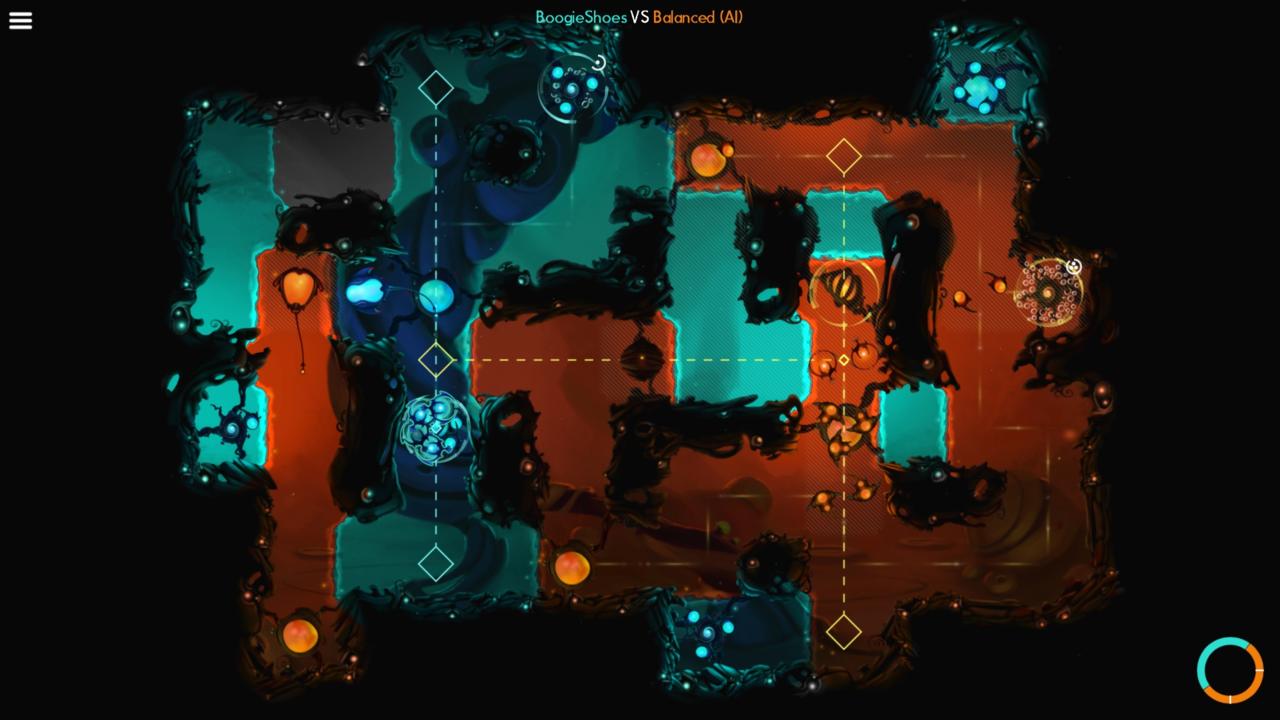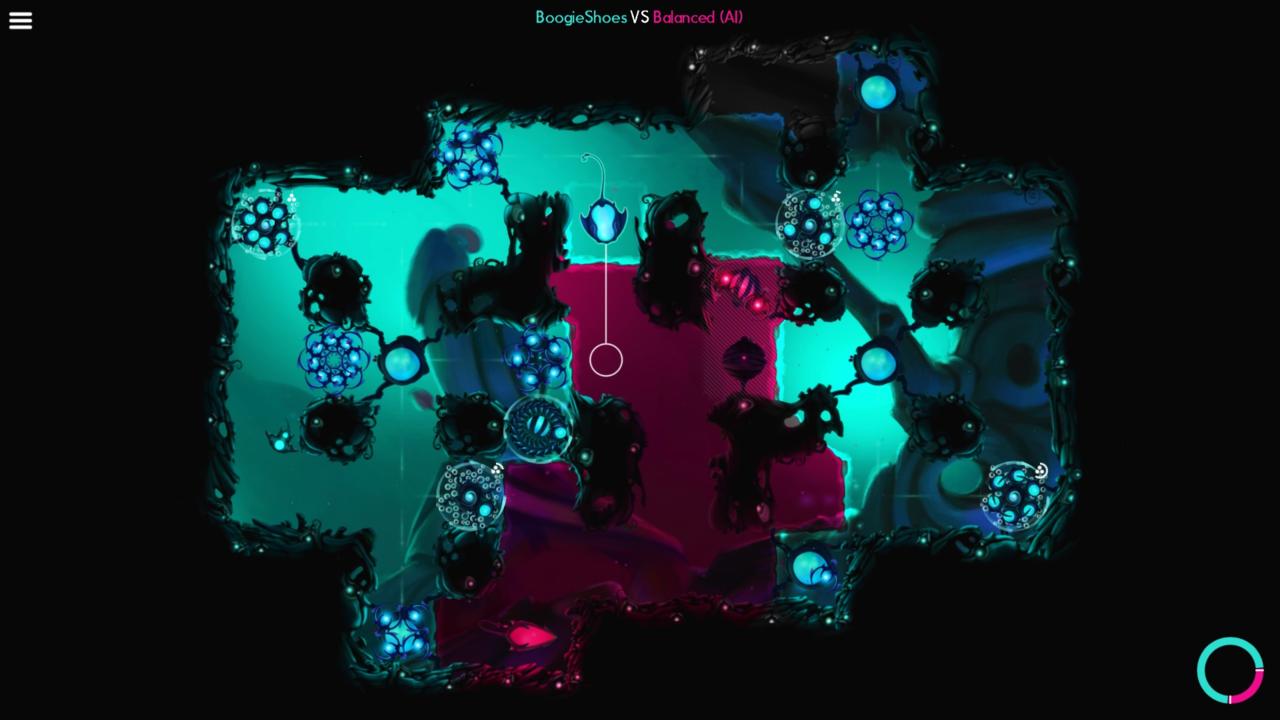Developer Monogon Games describes Interloper as a real-time strategy game with five-minute matches, but I would call it an RTS for people who hate the genre. This quirky example features all of the catchy conquering, tactical thinking, and fast-paced combat of the average real-time strategy game without being burdened by the base building, resource management, and game duration that scare off some of the potential audience. Toss in puzzle-like maps, an unusual setting, and faintly surreal visuals and sound, and you have a pick-up-and-play RTS for the masses that even genre veterans can appreciate for its innovations and challenge.
Simplicity is Interloper’s greatest asset. This is a two-player game in which you battle the AI or an online human opponent on small and slightly-less-small maps that never feature more than a handful of key assets to claim. The main unit is a Sentinel, a big mama that looks like a manta ray or some kind of microscopic bug, depending on which of the three tribes you are controlling (the appearance of Sentinels and color are all that differentiate the factions). Your goal is to swim through the fluid-filled corridors of each map (which are colorful and cute here, but would probably be gooey and gross in reality), claiming domain as you go. After you pass, tunnels turn your faction’s color, reminding me of ʼ80s arcade classic Crush Roller. Taking 75 percent of a map results in an instant win, which isn’t particularly easy as the enemy Sentinel and his pals are doing the exact same thing as you.

Maps feature a small number of key control points that are claimed by Sentinels. You provide juice to unit-producing centers called Assemblers by connecting them to local Power Sources, at which point they begin to automatically crank out Drones. In keeping with the quasi-organic appearance of the game, these core units look like spermatozoa...or tadpoles, depending on how you look at these things. Drones can then be used as shock troops to attack enemies en masse, or sent over to the only other building, the seed pod-resembling Factory. Here, multiple Drones are turned into the game’s three other unit types. Defenders absorb three hits of damage, making them great guards. Snipers automatically blast enemies from a distance with a recharging shot. And Destroyers serve as assault tanks that can take three hits as well, while also regenerating over time.
Movement and combat are straightforward. Basic units block Sentinels. They can phase past them, but are powerless when phased and cannot materialize back in until they reach neutral or already conquered domain. Unfriendly and neutral terrain causes automatic damage to traveling units. So you can’t tank-rush enemies without first laying down some serious friendly color on maps. Unprotected Sources can be taken over by the Sentinel in just a few moments, but Assemblers and Factories are off-limits while connected to a Source. Battles are simple wars of attrition. Drones kill each other one-to-one, so en masse assaults are a matter of simple math. Same goes with the other specialized units, which all come with set numbers of hit points noted above.
Simplicity is Interloper’s greatest asset.
The action reads more complicated than it plays. Matches are incredibly likable, compelling affairs. They move quickly, but they aren’t rapid-fire challenges to your carpal tunnel like so many other real-time games. I always had time to think before moving. This is good, because sober second thought is paramount when capturing and protecting those oh-so-valuable and oh-so-vulnerable Sources while also covering all avenues of enemy assault. Maps have a puzzle or even a bit of a board-game vibe, due to their layout and those maze-like corridors of goo. What you conquer and when you conquer are big factors as to how the war plays out.
Despite Interloper’s simple structure and quick matches, there are a lot of RTS basics under the hood here. Taking too much territory at the start of matches is a big mistake, for example. Whenever I ventured too far into the map to grab one more Source or one more Assembler, the enemy Sentinel crept in behind me to take over assets before I could get Drones produced to protect them. It’s a quick game, but trying to go too fast and steamroll the enemy isn’t a good idea.

Smart unit deployment is another essential. Even the three specialty units offer a lot of tactical depth. I loved using Snipers, which can be brutally effective at preventing enemy attacks and blowing away Drones on their way to enemy Factories. Get a mass of Snipers in the right place--which isn’t always easy, as the enemy does this, too--and I could lock down maps in short order by setting up murderous choke points. Defenders were incredibly helpful in blocking enemy approach routes and guarding Sources. And Destroyers were perfect for late-game assaults that cleaned up large numbers of enemy Drones. I loved rolling them out in the end to obliterate the last remnants of my rival’s sperm army.
Enemy AI is generally excellent when playing solo, which features a campaign of sorts with an absolutely perfect series of tutorials along with skirmish. The AI can also be adjusted via multiple settings that up the general difficulty, add to aggression, and so forth. I was challenged on most maps by the default AI. I could quibble with some of the computer’s tactics: it would occasionally get bottled up early on, which led to almost instant destruction, but it never failed to move in on areas that I left unprotected. And it sure did beat me on a fairly regular basis. Multiplayer is something of a concern right now, however. Not many people are playing, making it tough to find a match. Since the single-player is limited when it comes to the number of maps, this could impact longevity. Still, for $10, you’re getting a lot of game here.
Sober second thought is paramount when capturing and protecting those oh-so-valuable and oh-so-vulnerable Sources.
The atmosphere is distinct. I was never sure if I was in some kind of parallel dimension, a microscopic world of bacteria, or a stoner’s daydream, but it worked. Everything is weird, but not too weird, and the aesthetics never interfere with gameplay. Colors nicely blend light and dark, as well, with everything getting brighter and brighter and even pulsing if you’re cruising to a win. Sound is as offbeat as the graphics. A techno score reminiscent of second-rate Tangerine Dream (yes, that’s a compliment) and brittle sound effects accompanying unit destruction adds an oddly fitting, yet oddly sterile, sci-fi mood.
Interloper distills the core elements of every good RTS and adds a little extra to put it over the top. No matter if you love or loathe traditional real-time strategy, the deep tactics and puzzle solving crammed into a nicely condensed package here come highly recommended.